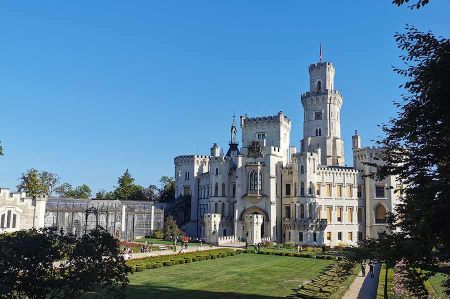Hluboká nad Vltavou – a magnificent castle with a park
- Written by Portal Editor
After our short visit through the city, the Frauenburg (Hluboká nad Vltavou) attracted us so much that we started the climb. Directly from the town centre or from the Hotel Podhrad for a forest path to the castle, which is, however, quite bumpy on the second section as it is very rocky.
In any case, sturdy shoes are recommended here (you can also go out by car, but there is only limited parking space available). After about 3 kilometres we reached Hluboká nad Vltavou and …… were very impressed. Not an ancient castle complex, more of a quite feudal castle with a huge park, simply fantastic (for everyone who likes castles).
Early history of the Hluboká nad Vltavou castle complex
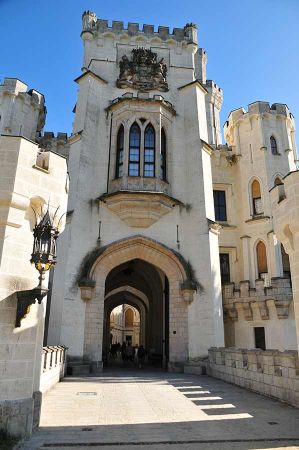 As already mentioned, a first castle/dwelling was built on the Frauenberg for guards who were stationed here to protect the transport of goods on the Vltava. Expansion after expansion followed, whereby it developed into a castle and thus into the royal seat of Froburg. The residence, built in the 13th century in the lower building of the Froburg royal castle (originally Wroburch), was first mentioned in 1378 in connection with Markt Podhrad. From the beginning, the castle was also called Hluboká in Czech, perhaps because of its former deep forest or elevated location.
As already mentioned, a first castle/dwelling was built on the Frauenberg for guards who were stationed here to protect the transport of goods on the Vltava. Expansion after expansion followed, whereby it developed into a castle and thus into the royal seat of Froburg. The residence, built in the 13th century in the lower building of the Froburg royal castle (originally Wroburch), was first mentioned in 1378 in connection with Markt Podhrad. From the beginning, the castle was also called Hluboká in Czech, perhaps because of its former deep forest or elevated location.
On November 16, 1351, the forces of Henry II from Hradec and Peter from Sternberg clashed here (on the right bank of the Vltava) with the units of Wilhelm von Landstein and the Austrian nobleman Eberhard VIII von Valsa (von Wallsee), who were with the Defeat of Jindřich of Hradec ended. This military encounter is known as the Battle of Zámostí.
Constantly new owners over the centuries
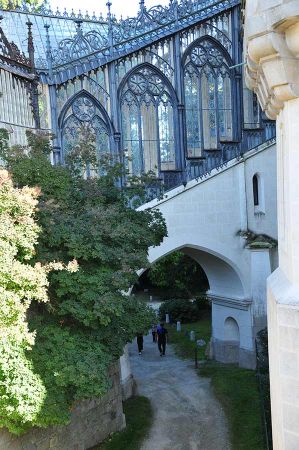 King Vladislav Jagiello pledged the estate along with the Kamýk estate to William of Pernstein in 1490. He had the castle expanded at the end of the 15th century and left it to his youngest son Vojtěch in 1514. After his death in 1534, his brother Johann inherited the property and left it to his cousin Andreas Ungnad von Sonegg. The disgrace of Sonegg brought the reign into ruin. King Ferdinand, I bought back the indebted estate in 1561 and sold it the following year to Joachim von Neuhaus. His son Adam sold the Kamýk estate to Jan Vojkovský of Milhostice in 1562 and had Hluboká Castle converted into a Renaissance castle by the architect Baldassare Maggi in the 1580s. In 1598, Joachim Ulrich von Neuhaus sold the Hluboká castle and estate to his creditor Bohuslav Malovec von Malovice due to excessive indebtedness. After financial speculation and participation in the estate uprising, the Malovec von Malovice estates were confiscated and the rule was transferred to Baltasar von Marradas in 1623, who had them re-catholicized. His heirs sold the estate to Johann Adolf I von Schwarzenberg in 1661. At the request of Prince Adam Franz, the castle was rebuilt in the Baroque style at the beginning of the 18th century according to plans by Paul Ignaz Bayer and his successor Anton Erhard Martinelli.
King Vladislav Jagiello pledged the estate along with the Kamýk estate to William of Pernstein in 1490. He had the castle expanded at the end of the 15th century and left it to his youngest son Vojtěch in 1514. After his death in 1534, his brother Johann inherited the property and left it to his cousin Andreas Ungnad von Sonegg. The disgrace of Sonegg brought the reign into ruin. King Ferdinand, I bought back the indebted estate in 1561 and sold it the following year to Joachim von Neuhaus. His son Adam sold the Kamýk estate to Jan Vojkovský of Milhostice in 1562 and had Hluboká Castle converted into a Renaissance castle by the architect Baldassare Maggi in the 1580s. In 1598, Joachim Ulrich von Neuhaus sold the Hluboká castle and estate to his creditor Bohuslav Malovec von Malovice due to excessive indebtedness. After financial speculation and participation in the estate uprising, the Malovec von Malovice estates were confiscated and the rule was transferred to Baltasar von Marradas in 1623, who had them re-catholicized. His heirs sold the estate to Johann Adolf I von Schwarzenberg in 1661. At the request of Prince Adam Franz, the castle was rebuilt in the Baroque style at the beginning of the 18th century according to plans by Paul Ignaz Bayer and his successor Anton Erhard Martinelli.
Fate and wars brought about change
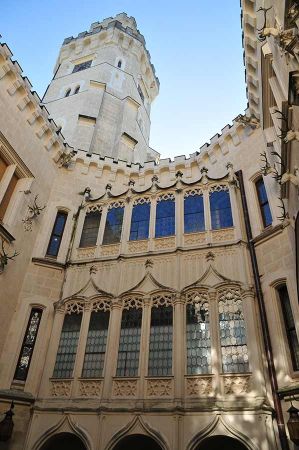 During the Thirty Years' War, the French occupied the castle, which was then besieged by the Austrians.
During the Thirty Years' War, the French occupied the castle, which was then besieged by the Austrians.
In 1742 the entire lower castle burned down. Joseph Adam von Schwarzenberg had the fortifications torn down after the end of the occupation so that they could no longer serve as a military base, but the area was still the headquarters of the Russian staff in the fight against Napoleon's troops from 1799 to 1800. The renovations turned the castle into a castle.
In 1741–42 (during the Wars of the Austrian Succession), Hluboká Castle was occupied by the French army and repeatedly besieged by the Austrian army. On May 25, 1742, the Battle of Zahájí took place near Hluboká.
In the years 1799–1800, during the Napoleonic Wars, there was a Russian regiment in the Hluboká winter camp.
Redesign Hluboká in the Romantic style
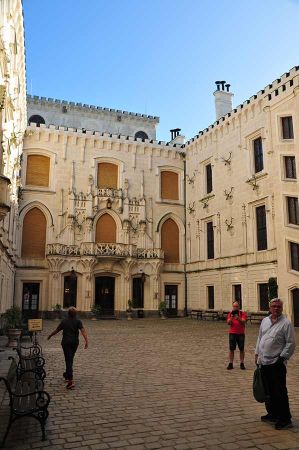 In the second third of the 19th century, Johann Adolf II, Prince of Schwarzenberg, decided to redesign Hluboká in the Romantic style. The project, which belongs to the architectural historical context of the Castle Renaissance, was developed by the Viennese architect Franz Beer, who led the construction work, which began in 1840, for twenty years. The old buildings were demolished and a picturesque Tudor Gothic castle was built in their place. Ferdinand Deworetzky completed the sophisticated external and internal design in 1871.
In the second third of the 19th century, Johann Adolf II, Prince of Schwarzenberg, decided to redesign Hluboká in the Romantic style. The project, which belongs to the architectural historical context of the Castle Renaissance, was developed by the Viennese architect Franz Beer, who led the construction work, which began in 1840, for twenty years. The old buildings were demolished and a picturesque Tudor Gothic castle was built in their place. Ferdinand Deworetzky completed the sophisticated external and internal design in 1871.
Prince Adolph Schwarzenberg was expropriated by the German occupiers in 1939 on Heinrich Himmler's orders, got his property back in the Third Czechoslovak Republic in 1945 and was expropriated again by the communists in 1947 with the Lex Schwarzenberg. His heir Karel Schwarzenberg, later Czech Foreign Minister, did not challenge this law through legal means after 1990.
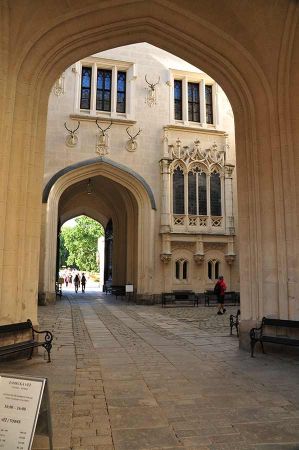 On January 25, 1945, a death transport with half-naked prisoners on open wagons passed the Hluboká nad Vltavou-Zámóstí train station. After the train passed, four dead prisoners lay on the tracks. After the end of World War II, German soldiers who wanted to be captured by the Americans fled through Hluboká and threw away their weapons. On May 10, 1945, a truck carrying 35 Wehrmacht members was stopped on the road near a Jewish cemetery and shot by Soviet soldiers (exhumed in 1994).
On January 25, 1945, a death transport with half-naked prisoners on open wagons passed the Hluboká nad Vltavou-Zámóstí train station. After the train passed, four dead prisoners lay on the tracks. After the end of World War II, German soldiers who wanted to be captured by the Americans fled through Hluboká and threw away their weapons. On May 10, 1945, a truck carrying 35 Wehrmacht members was stopped on the road near a Jewish cemetery and shot by Soviet soldiers (exhumed in 1994).
In the second half of the 20th century there were major structural changes in the form of the city and its extra villa. Due to the construction of the Hněvkovice reservoir, which served primarily as a technical water source for the Temelín nuclear power plant, part of Purkarka was displaced and demolished.
Visit of the interiors
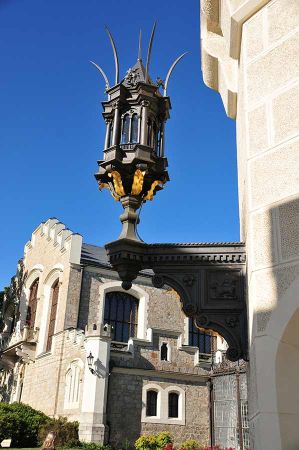 Walls and ceilings are lined with fine woods and rich carvings. The most valuable pieces of furniture are housed in the breakfast lounge. Princess Eleonore's bedroom and dressing room, the so-called Hamilton Cabinet and the reading room are decorated with pictures by European masters from the 16th to 18th centuries as well as chandeliers, vitrages and faience from Delft. The portraits on the walls represent the most important representatives of the von Schwarzenberg family. The largest hall is the library with a coffered ceiling that was brought to Hluboká from the ancestral castle in Schwarzenberg. The Hluboká Armory Chamber is of excellent quality. In the neo-Gothic chapel there is an altar with a large late Gothic ark.
Walls and ceilings are lined with fine woods and rich carvings. The most valuable pieces of furniture are housed in the breakfast lounge. Princess Eleonore's bedroom and dressing room, the so-called Hamilton Cabinet and the reading room are decorated with pictures by European masters from the 16th to 18th centuries as well as chandeliers, vitrages and faience from Delft. The portraits on the walls represent the most important representatives of the von Schwarzenberg family. The largest hall is the library with a coffered ceiling that was brought to Hluboká from the ancestral castle in Schwarzenberg. The Hluboká Armory Chamber is of excellent quality. In the neo-Gothic chapel there is an altar with a large late Gothic ark.
The former castle riding hall is now home to the South Bohemian Aleš Gallery (Alšova Jihočeská galérie) with an exhibition of paintings by Dutch and Flemish painters of the 17th and 18th centuries and statues.
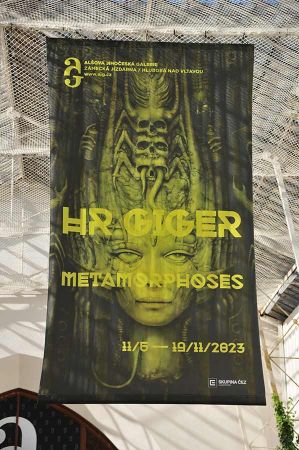 With the exhibition “Metamorphoses” the works of HR Giger can be seen for the last time and only until November 19th, 2023 in the Aleš South Bohemian Gallery of the former neo-Gothic castle riding school in Hluboká nad Vltavou in the Czech Republic, which we would definitely like to recommend. Since the surroundings also contribute to a longer stay, a short vacation is ideal here, which we were just able to experience. And not just for lovers of classic rock history, as Giger was also very active in the film industry. As early as 1968 he was working exclusively as an artist and filmmaker. As a set and costume designer, his style influenced well-known films such as Alien (1979) and Species (1995). For his work on Alien, Giger won an Oscar for Best Visual Effects in 1980 and his style became known to a wider audience.
With the exhibition “Metamorphoses” the works of HR Giger can be seen for the last time and only until November 19th, 2023 in the Aleš South Bohemian Gallery of the former neo-Gothic castle riding school in Hluboká nad Vltavou in the Czech Republic, which we would definitely like to recommend. Since the surroundings also contribute to a longer stay, a short vacation is ideal here, which we were just able to experience. And not just for lovers of classic rock history, as Giger was also very active in the film industry. As early as 1968 he was working exclusively as an artist and filmmaker. As a set and costume designer, his style influenced well-known films such as Alien (1979) and Species (1995). For his work on Alien, Giger won an Oscar for Best Visual Effects in 1980 and his style became known to a wider audience.
Aleš South Bohemian Gallery until November 19, 2023 (link to map)
Hluboká nad Vltavou 144, 373 41 Hluboká nad Vltavou, Czech Republic
Please read as well:
Nepomuk – not just a well-known dragon that no one wants
Blooming yellow gentian on the slopes of Walmendinger Horn
-
 Hluboká nad Vltavou - Castle in Tudor style
Hluboká nad Vltavou - Castle in Tudor style
Hluboká nad Vltavou - Castle in Tudor style
Hluboká nad Vltavou - Castle in Tudor style
-
 Hluboká nad Vltavou - Castle in Tudor style
Hluboká nad Vltavou - Castle in Tudor style
Hluboká nad Vltavou - Castle in Tudor style
Hluboká nad Vltavou - Castle in Tudor style
-
 Hluboká nad Vltavou - Castle in Tudor style
Hluboká nad Vltavou - Castle in Tudor style
Hluboká nad Vltavou - Castle in Tudor style
Hluboká nad Vltavou - Castle in Tudor style
-
 Hluboká nad Vltavou - Castle in Tudor style
Hluboká nad Vltavou - Castle in Tudor style
Hluboká nad Vltavou - Castle in Tudor style
Hluboká nad Vltavou - Castle in Tudor style
-
 Hluboká nad Vltavou - Castle in Tudor style
Hluboká nad Vltavou - Castle in Tudor style
Hluboká nad Vltavou - Castle in Tudor style
Hluboká nad Vltavou - Castle in Tudor style
-
 Hluboká nad Vltavou - Castle in Tudor style
Hluboká nad Vltavou - Castle in Tudor style
Hluboká nad Vltavou - Castle in Tudor style
Hluboká nad Vltavou - Castle in Tudor style
-
 Hluboká nad Vltavou - Castle in Tudor style
Hluboká nad Vltavou - Castle in Tudor style
Hluboká nad Vltavou - Castle in Tudor style
Hluboká nad Vltavou - Castle in Tudor style
-
 Hluboká nad Vltavou - Castle in Tudor style
Hluboká nad Vltavou - Castle in Tudor style
Hluboká nad Vltavou - Castle in Tudor style
Hluboká nad Vltavou - Castle in Tudor style
-
 Hluboká nad Vltavou - Castle in Tudor style
Hluboká nad Vltavou - Castle in Tudor style
Hluboká nad Vltavou - Castle in Tudor style
Hluboká nad Vltavou - Castle in Tudor style
-
 Hluboká nad Vltavou - Castle in Tudor style
Hluboká nad Vltavou - Castle in Tudor style
Hluboká nad Vltavou - Castle in Tudor style
Hluboká nad Vltavou - Castle in Tudor style
-
 Hluboká nad Vltavou - Castle in Tudor style
Hluboká nad Vltavou - Castle in Tudor style
Hluboká nad Vltavou - Castle in Tudor style
Hluboká nad Vltavou - Castle in Tudor style
-
 Hluboká nad Vltavou - Castle in Tudor style
Hluboká nad Vltavou - Castle in Tudor style
Hluboká nad Vltavou - Castle in Tudor style
Hluboká nad Vltavou - Castle in Tudor style
-
 Hluboká nad Vltavou - Castle in Tudor style
Hluboká nad Vltavou - Castle in Tudor style
Hluboká nad Vltavou - Castle in Tudor style
Hluboká nad Vltavou - Castle in Tudor style
-
 Hluboká nad Vltavou - Castle in Tudor style
Hluboká nad Vltavou - Castle in Tudor style
Hluboká nad Vltavou - Castle in Tudor style
Hluboká nad Vltavou - Castle in Tudor style
-
 Hluboká nad Vltavou - Castle in Tudor style
Hluboká nad Vltavou - Castle in Tudor style
Hluboká nad Vltavou - Castle in Tudor style
Hluboká nad Vltavou - Castle in Tudor style
-
 Hluboká nad Vltavou - Castle in Tudor style
Hluboká nad Vltavou - Castle in Tudor style
Hluboká nad Vltavou - Castle in Tudor style
Hluboká nad Vltavou - Castle in Tudor style
-
 Hluboká nad Vltavou - Castle in Tudor style
Hluboká nad Vltavou - Castle in Tudor style
Hluboká nad Vltavou - Castle in Tudor style
Hluboká nad Vltavou - Castle in Tudor style
-
 Hluboká nad Vltavou - Castle in Tudor style
Hluboká nad Vltavou - Castle in Tudor style
Hluboká nad Vltavou - Castle in Tudor style
Hluboká nad Vltavou - Castle in Tudor style
https://www.alaturka.info/en/czech-republic/cheb/6341-hluboka-nad-vltavou-a-magnificent-castle-with-a-park#sigProIde5a4ba286f
